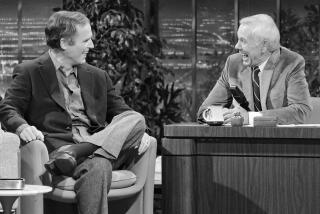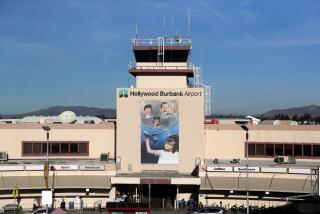Witness Describes Airport’s Birth at Its 60th Anniversary
- Share via
The crowd tingled with excitement on Memorial Day in 1930 as the biggest assemblage of aircraft in West Coast history gathered to dedicate United Airport, which then was the last word in airfields.
When the hundreds of bombers, fighters and private planes simultaneously fired up their engines on command for a ground-rattling flyby, said David M. Simmons, “it was electrifying--Disneyland and the greatest Fourth of July rolled into one.”
Simmons, then a 14-year-old boy enamored of airplanes, was the featured guest Wednesday at the 60th anniversary celebration of Burbank Airport--the most recent of five names for the airport that six decades ago was carved out of olive groves and chicken farms at the base of the Verdugo Mountains.
Simmons, who went on to become a Lockheed Corp. vice president and, in the 1970s, manager of what was then called Hollywood-Burbank Airport, flew with his pilot father from Santa Monica that morning in 1930 to witness the celebration that inaugurated service at the field.
“No one in the crowd that day had ever visualized that much air power in one place,” he said.
The airport, built by United Airlines, also turned heads.
Until then, Southern California airports tended to be grassy strips with a few hangars and a bucolic ambience. But United Airport was paved and designed for commercial aviation “with everything up to date, including the passenger terminal,” said Simmons, who retired from Lockheed five years ago.
Passenger traffic zoomed to 1.2 million in 1946, said Burbank Airport spokesman Victor J. Gill, then plummeted as airlines, swamped by the post-World War II explosion in demand for air travel, moved en masse to Los Angeles International Airport.
“We had something like 600 acres here and Los Angeles had about 2,900,” Simmons said, “and the airlines needed longer runways and more parking, so they left.”
The airport is now operated by the Burbank-Glendale-Pasadena Airport Authority, named for the three cities that bought it from Lockheed in 1978. In the 44 years since the mass airline exodus, it has come back slowly, reaching 3 million passengers in 1988.
But on that sunny day 60 years ago, Simmons said, “Everyone knew this was the start of a new age in aviation.”
More to Read
Sign up for Essential California
The most important California stories and recommendations in your inbox every morning.
You may occasionally receive promotional content from the Los Angeles Times.













